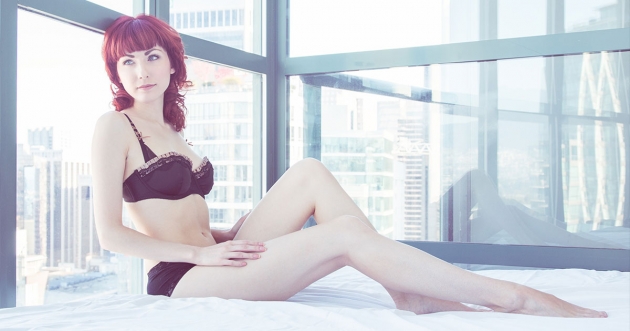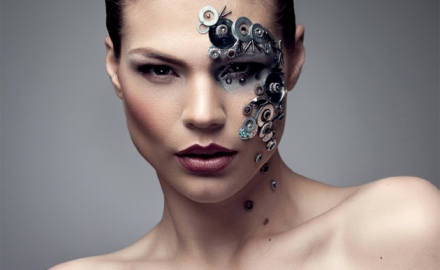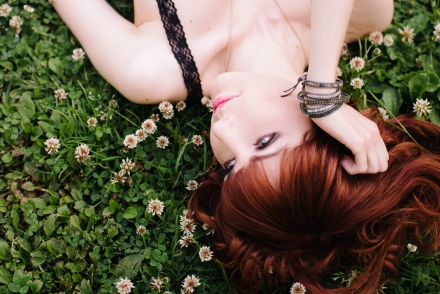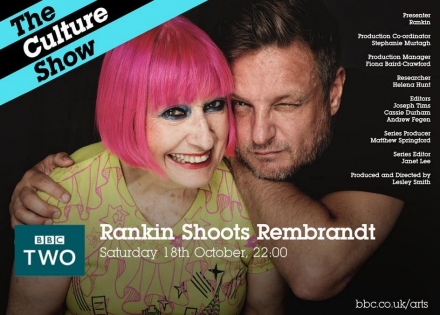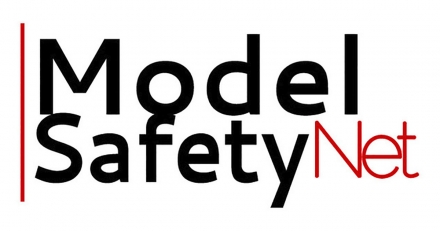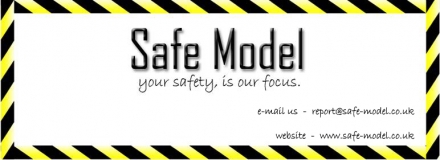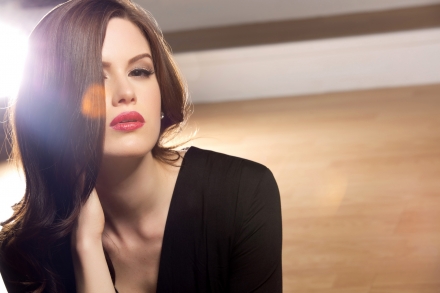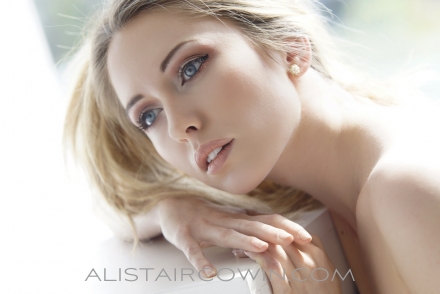What got you started as a model?
I started modelling 5 years ago. It was never something I had considered, and I fell into it almost by accident. Working as a professional dancer, I was participating in some photo shoots to promote an upcoming show. Finding myself extremely nervous, I organized a couple of casual shoots to get myself more comfortable and confident, and I ended up really loving it. I found myself shooting in all of my spare time, and really enjoying it as another creative outlet and means of performing. Soon I realized that there was professional work I was suitable for, and it really took off from there. I worked freelance and found my own bookings through networking and referrals. Vancouver is a small industry and I worked hard to gain a very professional reputation. Years later modelling has brought me to Toronto where I am working full time as a model and dancer.

Photo by Bent Photo
What did you study at school/university, and what were the most useful subjects in retrospect?
I went to a fantastic arts school where I focused in dance and choreography, but also studied music, visual art, drama, creative writing, and photography. I am extremely grateful that I was exposed to the arts at a young age, and that I had the opportunity to explore many creative subjects during my schooling. My school was full of creative, like-minded people, and it was amazing to grow up around other artists. Looking back, I think that everything I studied is useful in my life today. It all gave me great insight into the industry I’m now working in, and it really helped to prepare me for this career. I spent a lot of time juggling all of my interests in school, and also prioritizing my time between academics and the arts. It definitely prepared me for the schedule I have now, and I’m very grateful that I’m capable of balancing it all.
What was the turning point in your modelling that changed it from a hobby into a full-time career?
It didn’t take long before I started taking modelling seriously and pursuing it professionally. Once I realized that I didn’t need to fit all of the model standards we are familiar with, I had the confidence to throw myself into the industry. In Vancouver, the fashion industry is only a very small corner of the modelling world. There is plenty of commercial print work that doesn’t have such strict limitations on height, size, etc. I have a versatile look which lends well to commercial projects as well as some editorial work, and I also marketed myself to photographers for their own personal projects. My passion for the industry has definitely helped me develop modelling into a career, but more importantly I think it has been my drive, my organization, and my professionalism that has allowed me to pursue it full time.

Photo by Ryan West Photo
Did you have a backup plan? What career would you have now if you weren’t a model?
If I didn’t find a career in the arts, I probably would have gone into business. I’ve always been interested in marketing, advertising, and brand presence, and I could see myself running a small business or working in the marketing and advertising field.
I’ve found that all of these interests are actually a part of what I’m currently doing, and so I feel that I have the best of both worlds. I’ve worked closely with businesses and advertising agencies as a model, and it’s been amazing to bring their campaigns to life. I’m also putting my business mind to work every day by promoting myself as an artist. I developed my own brand as a performer, and I market myself in the industry. Being a freelance artist I am essentially running my own business!
What do you think helped you get where you are now?
A combination of things got me to where I am now, and I think any model would say the same thing. Some of it definitely has to do with my look, and how it makes me marketable. My background in the arts and experience as a performer also contributes. Above all, I believe it comes down to my personality, my desire to succeed, and my professional manner. The compliment I receive most consistently from clients isn’t about my talent as a model, it’s about my professionalism. I would say it is the number one thing that has gotten me to where I am. By representing myself in a professional way, I’ve been able to build and maintain a positive reputation that keeps me working. It is present in everything I do including my social media habits, my email correspondence, my etiquette on set, and my ability to follow up with the client and maintain a working relationship after the job is done. Every little bit helps to propel my career forward. I’ve landed numerous jobs because of referrals from clients, or because my professionalism has put me ahead of other talent with a similar look and experience. Dancing on a Nickelodeon TV Series, and modelling for the Coca-Cola brand, are both thanks to that. I’ve learned that it really DOES matter how we act and how we represent ourselves.

Photo by Eric Newby
What made you choose to specialize in your preferred genres?
I think we all end up falling into the genres we are most suited for, and the styles we are most comfortable with. My height and my look make me ideal for commercial work, but I really enjoy exploring all the styles I am capable of doing. I’m really glad that I’ve pushed the boundaries and worked in a variety of genres. I hope I don’t ever settle for just one style.
How has your modelling evolved over time?
When I started modelling I began doing a lot of pin-up, vintage glamour, and boudoir. Then I explored more commercial work and focused on bridal, advertising campaigns, and catalogues. I think I’ve definitely refined my interests and found what I excel at, but I still keep an open mind and accept work in a variety of styles. I’m currently shooting in many genres including dance photography, boudoir, pin-up, fashion, bridal, hair, and more. I’m also working on publications for advertising campaigns, clothing catalogues and look books, magazine print ads, and magazine editorials. Recently in Toronto I have worked with several fine art photographers on gallery pieces. I can’t say I ever expected to be hanging in a gallery, but it’s been an amazing experience. I was recently featured in several pieces in The Artist Project, a contemporary art fair showing the work of established contemporary artists of different mediums. I was also featured in two pieces that were up for auction as part of SNAP Toronto, in support of the AIDS Committee of Toronto.

Photo by Adrian Holmes
When shooting boudoir and implied nudes, are your levels in place for your partner, your professional career, or yourself?
My shooting parameters are definitely in place for my professional career. Personally, I’ve always been very open-minded about nudity and I’ve chosen to explore it to some degree in my work. I’m very comfortable incorporating boudoir and implied nudity in my portfolio, as I see no problem with utilizing my body to create art. The guidelines I use help me to maintain a reputation that is suitable for the commercial market I work in. Despite my personal views, I still need to adhere to the industry. My partner is extremely supportive in all of my decisions, and she encourages me to make the best choices for my career.
Are people surprised when they find out you’re engaged to a woman?
Yes they definitely are. I’m very open in my professional life and I’ve never hidden the fact that I’m in a same sex relationship. I think it’s important as a woman in this industry to be out, as it helps knock down all of the typical lesbian stereotypes.
Have you worked on any projects or campaigns to help promote marriage equality and gay rights?
Yes, absolutely. I’m a huge advocate for marriage equality and LGBTQ rights, and my partner and I recently worked on a project in Toronto. In support of PFLAG, we organized a photography workshop at a local studio and raised over $500 for the charity in the one day event. Local Toronto artists attended, all with an interest in shooting a same sex couple and contributing to our cause. We were overwhelmed by the love and support we received over this project. We’ve remained in contact with the charity and hope to volunteer with them on some upcoming events. My partner Stephanie also made a video documenting the photoshoot and we have been circulating it to spread our message. The video will be featured in a LGBTQ art exhibit at Union College (New York) this Fall. You can watch it here:http://vimeo.com/89684548

Photo by Della Pham
Describe one of the best shoots you’ve ever done
When I was working in Vancouver, I got booked on a commercial print ad for SPORTCHEK. It was amazing to model for such a big national brand, and the team on board was fantastic to work with. They were shooting a variety of looks for their upcoming Fall campaign, and I was cast in their “Back to School” advertisement featuring their different clothing brands. We shot outdoors at UBC and I worked alongside 3 other models. Everyone on set was extremely friendly and laid back, and it was an amazingly casual day considering the big brand and the pressure of the shoot. It was an incredible experience.
What travels have you had because of your modelling?
I try to work modelling in to my personal travels, and I’ve shot with photographers all over Canada. This summer I am taking bookings in both Vancouver and Calgary. I also plan on doing a tour through Australia within the next year, and hopefully Europe after that. I definitely enjoy modelling while I’m travelling. It’s a great way to explore new cities and meet local artists.

Photo by Eric Marcina
Being a model isn’t as glamorous as the finished photos suggest. What are the best and worst things about being a model?
It’s true, there are many factors that aren’t always “glamorous”. Early morning call times, long days, hours of waiting around, and sometimes shooting on location in terrible conditions. The industry is also full of stereotypes that I constantly have to overcome. I always try to display my mature, intelligent, and informed nature, but these qualities can often be overlooked simply because I am a ‘model’. It’s typical to only be seen as an object, rather than an artist who is also contributing to the project. Despite it’s downfalls, I wouldn’t trade it for anything. Modelling is something that allows me to be a performer, to create art with other talented artists, to constantly meet new people and explore new places. It’s brought so much out in me that I never would have found on my own.
Which do you prefer, studio shoots, room shoots, or outdoor location shoots?
I enjoy shooting in studio because everything is simple and easy to control. On location you are battling the light, the weather conditions, the pedestrians, and so many other factors. Sometimes it is nice to shoot in an apartment or hotel room because it can really add another dimension to a shoot. It’s also great to have a variety of walls, textures, and furniture to work with, rather than a studio which can be quite static.

Photo by Adrian Holmes
What advice would you give models starting out?
I would say that the most important thing is to find where you fit in to the industry. Realize your potential and what makes you marketable, and then figure out how that translates into certain genres. Not all models need to be 5’9″ and a size zero. Outside of the fashion world, there are many other markets requiring commercial, alternative, glamour, or fine art models. Once a new model has realized their place in the industry, they should gain as much experience as possible and build their portfolio to a professional level. They should network with other artists and represent themselves positively and professionally at all times. They also shouldn’t feel afraid to dive into the freelance market. I think that it’s a bit of a misconception that you need an agent to be a model. My advice would be to take their career into their own hands and market themselves as a freelance model. Use social media and model networking sites as tools to build a good reputation and connect with others in the industry. Then later if it makes sense to also be represented by an agency, then they already have experience and a good body of work to start with.
What’s it like being signed with an agency versus being a freelance model?
I would say there positive and negative factors for both. Being signed with an agency gives you the opportunity to be considered for large projects depending on what market you are right for. A fashion agency has the ability to send you overseas for contracts, and can get you walking for big designers. A commercial agency will promote you to big print clients, and can also market you for film and television. It can be difficult to find an agency that you can have a good relationship with, and one that is willing to promote you aggressively. Sometimes it feels better to take things into your own hands and market yourself.
As a freelance model you are in complete control of the work you take, but you are also responsible for finding every opportunity. A lot of people aren’t willing to put the work in, because it can be tedious, time consuming, and sometimes unrewarding.
I personally prefer a combination of the two. Being signed with an agency non-exclusively gives me the flexibility to freelance on the side. I love being in control of my schedule and deciding what jobs I want to take and when. I definitely spend a lot of time on bookings. Sifting through castings, submitting myself for work, finalizing details, confirming dates and times, and following up with clients is probably half the job!

Photo by Toni Wallachy
Do you have any particular models and photographers who really inspire you?
The models and photographers who inspire me most aren’t the household names we think of in the industry. Rather, they are the artists I work with day to day. I am constantly inspired by the talent I get to collaborate with on each and every project. Everyone brings their own perspective and vision to the work, and the final product is an amalgamation of each artist’s personal creativity.
If you could re-create any famous photo, which would it be, and what would you do differently to make it your own?
Although they aren’t photographs, I love all of the Degas paintings of dancers. I would love to recreate them as modern photographs, but still with a very classic feel.

Photo by Laura Wichman
Many models have a background in dance, and it’s clear this helps with their posing ability – is there a demand for more multi-talented models, who can do their own hair & make-up, or who have acting/singing/dancing talents?
Being a dancer definitely makes me more marketable as a model. Lots of clients see it as an asset because of my body awareness, and also because it keeps me in good physical shape. I also book a lot of modelling work that requires a dancer specifically. I’ve worked on lots of dance photoshoots and get requests for dance themes constantly.
Being a model that can do her own hair and makeup is also a very marketable skill. After being a model for a few years, I decided to attend makeup school in Vancouver. I studied at VCC under Jason Hadikin, and furthered my knowledge through seminars with MAC and Makeup Forever. I frequently get hired to be my own hair and makeup artist for both creative and commercial shoots.
How would dancers and the dance world benefit from having a site like Portfora, to showcase talented performers, and make it easier to fill castings and get more opportunities?
The dance industry is interesting because lots of small opportunities are filled by word of mouth, and most big opportunities are filled by auditions. I don’t often submit my online materials for a dance job, I’m either booked by referral or invited to audition in person. I think it’s great to have everything online where it’s easily viewable, and hopefully in the future a site like Portfora will be useful for all types of performing artists including dancers, actors, singers, and more.

Photo by Raymond Fryer
Do you have a goal, something you’d like to achieve from your modelling or dancing?
There are many things I hope to achieve during my career, but my main goal is to continue making a living being a performer. I feel fortunate every day to be doing what I love and making a career out of it.
Where do you see your modelling career going?
I plan to model for as long as I can, and when I stop I know that I will still remain in the industry. I have many goals for my career that I hope to accomplish in the next couple of years, including working throughout Australia and Europe as a travelling model. I’m also a professionally trained makeup artist, and I plan on transitioning into makeup at some point. Other goals I have for the future are managing a studio, and training new models.

Photo by filmWERX Studio
Tell us about your social media habits, and top tips
I use social media to promote myself as a model and performer. I actively update my Facebook page (KaitlinChappleModel), my Twitter account (@KaitlinChapple), and my Instagram (@KaitlinChapple), as well as my own website (www.kaitlinchapple.com). It’s important to me to always represent myself online in a very professional and positive way. In order to maintain my brand, I choose to post only content that is relevant to the work and the industry. My top tips are to keep everything current, develop your personal brand, and market yourself appropriately.
What do you like best about Portfora so far?
I love the Portfora brand. Its design is very clean, elegant, and beautiful. I also think it’s very user friendly and focuses on bringing the artist community together, which is very important. I look forward to seeing how the site grows and evolves.
Thanks very much for speaking with us Kaitlin. To finish off, is there a quote or pearl of wisdom that you’d like to share?
“A girl should be two things: who and what she wants.” – Coco Chanel
Discovering and accepting ourselves is the most difficult yet rewarding thing we will ever do as people. I firmly believe in living life as the person you want to be, and not who anybody else expects you to be.







